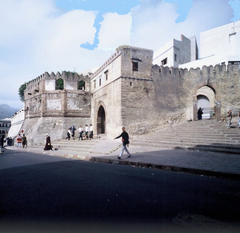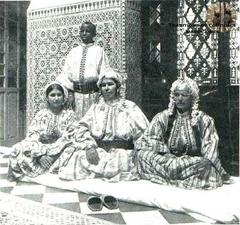Bab Rouah Visiting Hours, Tickets, and Historical Sites in Tetouan, Morocco
Date: 14/06/2025
Introduction: Bab Rouah’s Place in Tetouan’s Heritage
Tetouan, nestled in northern Morocco near the Mediterranean coast, is celebrated for its unique blend of Andalusian and Moroccan heritage. This fusion is most evident within its UNESCO-listed medina, a living museum of architectural splendor and vibrant culture. Among the medina’s historic gates, Bab Rouah—the “Gate of the Winds”—stands out as both a practical passageway and a symbolic bridge between Tetouan’s storied past and its dynamic present.
Bab Rouah welcomes visitors into the labyrinthine heart of the medina, surrounded by artisan quarters, bustling souks, and historic sites. This guide provides a comprehensive overview of Bab Rouah’s significance, visiting logistics, nearby attractions, and practical travel tips to enrich your experience in Tetouan.
For further details and virtual exploration, authoritative resources such as Visit and Do, Adam Vanecko Traveller, and the UNESCO World Heritage Centre offer invaluable perspectives.
Table of Contents
- Introduction: Bab Rouah’s Place in Tetouan’s Heritage
- Historical Background and Significance
- Architectural Features of Bab Rouah
- Visiting Hours, Tickets, and Accessibility
- Guided Tours and Special Events
- Cultural and Urban Significance
- Nearby Attractions
- Preservation and UNESCO Status
- Travel Tips and Visitor Information
- Frequently Asked Questions (FAQ)
- Visual Gallery
- Call to Action
- References
Historical Background and Significance
Tetouan’s origins date back to the 8th century CE, but its medina as seen today was shaped by Andalusian refugees expelled from Spain in the late 15th century. The city’s medina is encircled by fortified walls punctuated by several monumental gates, each with its own story. Bab Rouah, meaning “Gate of the Winds,” is among the most important, constructed to serve both defensive and administrative functions while facilitating commerce and travel (Adam Vanecko Traveller).
Though Bab Rouah is more recent compared to gates like Bab el Okla, it harmonizes with the medina’s architectural traditions, echoing the city’s identity as a crossroads of cultures and a center for artistic and economic exchange (Visit and Do).
Architectural Features of Bab Rouah
Bab Rouah exemplifies the Hispano-Moorish style that defines much of Tetouan’s medina. Built from local stone and lime, its horseshoe-shaped arch, robust masonry, and subtle geometric motifs reflect both defensive intent and artistic sensibility (Visit and Do). Inscriptions in Arabic script and carved patterns on the gate’s façade are a nod to the Andalusian legacy.
The gate’s strategic location provides access from major squares such as Place El Mechouar, integrating seamlessly with the medina’s main arteries and public spaces. Its orientation also allows natural ventilation, a practical feature for the dense urban fabric (Adam Vanecko Traveller).
Visiting Hours, Tickets, and Accessibility
- Visiting Hours: Bab Rouah is an open public gate, accessible 24 hours a day. For safety and the best experience, visit during daylight hours, generally between 8:00 AM and 6:00 PM.
- Tickets: No entry fee or ticket is required to visit Bab Rouah or enter the medina.
- Accessibility: The gate’s wide design is more accommodating for visitors with mobility needs than some of the older gates. However, the medina’s narrow, uneven streets may pose challenges—consult with local guides for accessible routes (Bewildered in Morocco).
Guided Tours and Special Events
Bab Rouah is a popular starting point for guided tours of the medina. Many local agencies and the official tourist office offer tours that blend historical commentary with visits to artisan quarters, markets, and museums. The gate and its surrounding square occasionally host cultural events, particularly during festivals and citywide celebrations (Visit and Do).
Cultural and Urban Significance
Bab Rouah is not just an architectural relic but a living symbol of Tetouan’s openness and resilience. As a gateway, it embodies the transition from the modern city to the historic medina, making it a constant in the daily rhythms of local residents. It is a favored meeting spot, especially during public events and religious processions, and plays a key role in the community’s cultural life (Morocco Travel Blog).
The gate’s proximity to landmarks such as the Royal Palace and Place Hassan II further cements its status as a hub of urban activity.
Nearby Attractions
From Bab Rouah, visitors have easy access to:
- Royal Palace and Place Hassan II: Iconic structures at the heart of Tetouan’s civic life.
- Grand Mosque (Jamaa El Kbir): While non-Muslims cannot enter, the mosque’s minaret is an architectural highlight.
- Artisan Quarters: Explore workshops producing traditional crafts, ceramics, and textiles.
- Kasbah of Tetouan: A 14th-century fortress reflecting the city’s defensive history.
- Ethnographic and Archaeological Museums: Offering deeper insight into the region’s history and culture (Adam Vanecko Traveller).
Preservation and UNESCO Status
Tetouan’s medina, including Bab Rouah, was inscribed as a UNESCO World Heritage Site in 1997. Ongoing preservation efforts maintain the authenticity of its architectural and cultural heritage, ensuring that both residents and visitors can appreciate the city’s unique legacy (UNESCO World Heritage Centre).
Travel Tips and Visitor Information
- Getting There: Bab Rouah is reachable by foot from the city center or by taxi. Local buses also serve the medina area (Evendo).
- Best Times to Visit: Spring (March–May) and autumn (September–November) offer the most pleasant weather. Early mornings and late afternoons are ideal for avoiding crowds and capturing the best light for photography (Malika in Morocco).
- What to Bring: Modest clothing, comfortable walking shoes, sunscreen, and water are recommended. Always ask permission before photographing people.
- Amenities: Cafés, restaurants, and shops are located nearby, though public restrooms are limited within the medina.
- Language: Arabic and Spanish are widely spoken, with some French and English.
Frequently Asked Questions (FAQ)
Q: What are Bab Rouah’s visiting hours?
A: Bab Rouah is accessible 24/7, but daytime visits (8:00 AM–6:00 PM) are safest and most enjoyable.
Q: Is there an entry fee or ticket required?
A: No, Bab Rouah is free to access.
Q: Are guided tours available?
A: Yes, many tours start at Bab Rouah. Booking in advance is recommended.
Q: Is Bab Rouah accessible for people with disabilities?
A: The gate is wider and more accessible than older gates, but the medina’s streets can be difficult for wheelchairs.
Q: What are the best times to visit Bab Rouah?
A: Early morning and late afternoon provide cooler temperatures and fewer crowds.
Visual Gallery
The iconic horseshoe-shaped archway of Bab Rouah, showcasing Hispano-Moorish design.
Close-up of the carved geometric patterns and Arabic inscriptions on Bab Rouah.
Call to Action
Ready to discover Bab Rouah and the wonders of Tetouan’s medina? Download the Audiala app for guided tours, event updates, and personalized travel tips. Follow us on social media for the latest inspiration and cultural highlights. Share your experiences with #BabRouahTetouan and join a community of curious travelers!
- Instagram: @AudialaTravel
- Facebook: Audiala Travel

